
Instead of a preface
“…It was getting more and more fun in Ivano-Frankivsk and across Ukraine in general. One could not help but travel here and there. We entered the festival strip of our most recent history.
What do I mean?
Try to follow me. It seems that it was the first Chervona Ruta Festival in Chernivtsi that marked the beginning of it, but I couldn’t show up there. But in November 1989, I had to be at the first Impreza, and with its help, we opened the city through all its gates, so crowds of foreign adventurers, NATO aggressors, and CIA agents rushed into it. Before Impreza, it was a completely closed city, can you imagine? It should not exist on any map, including any cultural map. And then a bunch of crazy people—Mykola Ya., Punch, Vitushynskyi, and someone named Yu.A.—throw an international biennale of contemporary art in it.
Back then everyone wanted some contemporary art, the legalization of the blue and yellow flag and state independence, exactly in this sequence—today is art, tomorrow is the flag, and the day after tomorrow is independence. And all this was combined in Impreza.
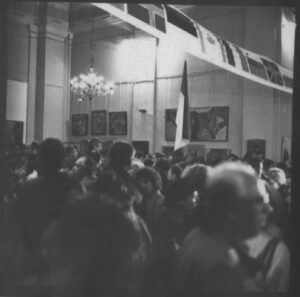
1989.
That’s how, in his memoir novel The Secret, Yurii Andrukhovych described the first Impreza—an international biennale of contemporary art, which took place in 1989 and was held until 1997, becoming a unique experience in the history of Ukrainian art life.
So what was Impreza and why is it important for us to know about it?
Impreza: the beginning
1987. An unprecedented event, the first group exhibition of young artists, took place in Ivano-Frankivsk. Probably, it was the first uncensored exhibition after World War II. Mykhailo Vitushynskyi, Mykola Yakovyna, Ihor Panchyshyn, Zoriana Onyshchenko, and Marta Bazak took part in it.
The young artists were lucky to enlist the support of the then-head of the regional department of culture Mykola Tokarenko. Mykhailo Vitushynskyi described this story like this: “…Yakovyna, who was more in touch with Tokarenko, brought us such information. He said: you know guys, he is a very interesting personality—he is erudite, educated and the one you can talk to. And that’s why we turned to him to help us make our first group exhibition without being censored by the Artists Union.”
They wanted to hold the exhibition in the hall of the Artists Union, but they got a refusal because the participating artists were not part of the organization. So, it was moved to the Local History Museum. The public liked the exhibition which inspired the artists to continue.
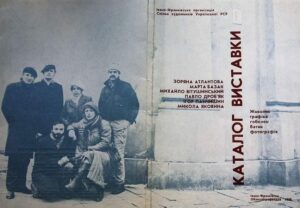
1988. Thanks to his wife’s aunt, who was a Polish opera singer, Mykhailo Vitushynskyi met Grzegorz Matuszak, a professor of sociology, art critic and longtime commissioner of the International Biennale of Small Graphic Forms in Lodz. Matuszak offered to do a similar event in Ukraine.
“When we talked about the Lodz Biennale, he said: what if we organize such a biennale in Ukraine, and I said to him: maybe someday it will be in Ukraine, too. But my wife said: oh, Misko (short for Mykhailo), why don’t you hold the biennale in Ivano-Frankivsk. And I thought: what is she talking about, it’s all so complicated, and we are too young to be capable of doing this. And Matuszak said: but why? I will advise you, help you, tell you how to do everything, I assure you, it’s not that difficult. When I returned to Ivano-Frankivsk, I shared my thoughts with Mykola Yakovyna. Mykola is a rebellious person by nature and so he said: let’s do it.”
It was necessary to gather a team and negotiate with the authorities, as Ivano-Frankivsk was a closed city: military and regime facilities were located there, and foreigners were not allowed to enter. Mykola Tokarenko, who once supported young artists, decided to dedicate the biennale to the 70th anniversary of the reunification of Western Ukrainian lands. The event was scheduled for 1989.
The invitation to participate stated that the Impreza-89 Biennale was intended “…to show and compare national images of the world and the view of man embodied in various art systems based on the latest interpretations of classical and folklore heritage.”
And so Impreza started.

What Impreza was like
The first Impreza lasted for two months in the exhibition halls of the Ivano-Frankivsk State Art Museum, the regional organization of the National Union of Artists of Ukraine, and the Regional Local History Museum. The event received more than 3,000 pieces by 400 artists from 19 countries. 700 pieces by 250 artists were selected.
The biennale ended in an auction, which was also a unique event for those times and was held for state galleries, art museums, exhibition halls, national and foreign collectors.
The content of the exhibitions ranged from purely modern to postmodern.
The second Impreza-91, held in an already independent country, took place in the Gartenberg Passage. Back then, they said that the building could host the future Museum of Contemporary Art—the emergence of such a museum in the city was one of the goals of the Impreza community. At the second biennale, the boundaries of art were finally erased: in addition to exhibitions, the program included various musical and theatrical events, and literature appeared.
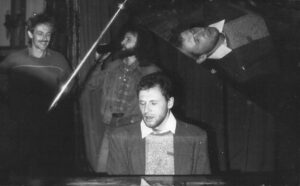
Iurii Izdryk. 1991
The second Impreza turned out to be the richest and most powerful, both in terms of content and participants. In 1993, the event lost some of its passion. And the Gartenberg Passage never became a museum but was transferred to private ownership. Instead, the third biennale finally got its own catalog. Its preface read:
“We gain experience of living in circumstances unusual for a healthy society. The young world that is being born looks to the future boldly, realizing its purpose. On the threshold of the new millennium. Art awaits the arrival of a new generation, respectfully drawing on the experience of those who have prepared and are preparing the future.”
People of Impreza
Impreza brought together a wide variety of Ivano-Frankivsk artists. Here are the names one surely needs to remember:
- The three founders of the Biennale were Mykhailo Vitushynskyi, Ihor Panchyshyn, and Mykola Yakovyna.
- Among other active and notable participants were Anatolii Zvizhynskyi, Myroslav Yaremak, Yaroslav Yanovskyi, Nazar Kardash, Volodymyr Mulyk, and Rostyslav Koterlin.
Anatolii Zvizhynskyi is an artist and curator. He organized one of the most significant first exhibitions, Provincial Annex 2, which was part of the Impreza parallel program. He then took over the curatorship of the Fourth and Fifth Biennales, which were truly postmodern.
Myroslav Yaremak is a conceptual artist and founder of one of the first private galleries in Ivano-Frankivsk, S-Objects. He was one of the participants of the Provincial Annex 2 exhibition with his performance On Integrity. The peculiarity of that exhibition was that the artists did not focus on the painting, but on the space in which the exhibition was held. Its program included installations and performances, and the project itself became the first show of postmodern art in Ivano-Frankivsk.
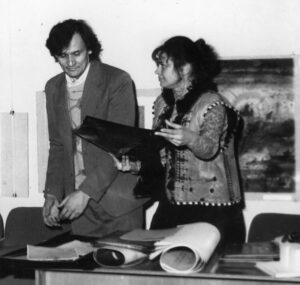
Myroslav Yaremak. 1992
Yaroslav Yanovskyi is an artist who has participated in more than a hundred actions and programs of contemporary art in Ukraine and abroad. In his interview, he described his creative work as follows: “To a larger extent, I’m an intuitive artist. I work with the so-called sixth sense, which I visualize and verbalize in various forms. That is, I comprehend not with my head, but with my heart, or even, as they say, my ‘intestines’. Thus, I would define my creative work as intuitive expressionism. My sculptures are also built on intuition, as well as my performances and videos, and any form of vision.”
Rostyslav Koterlin is an artist and author of the In the End magazine on contemporary art. One of his most iconic exhibitions was Personal Structures – Open Borders as part of the parallel program of the Venice Biennale 2017. Rostyslav Koterlin was then the only one who represented Ukraine with his project Migrating Soul.
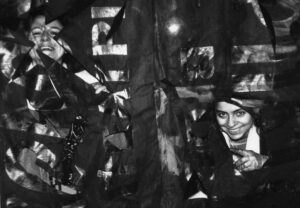
Installation of Rostyslav Koterlin. 1991
Why Impreza is important
The fact of the existence of the International Biennale of Contemporary Art in the then-Soviet Ivano-Frankivsk is absolutely unique. Impreza became the first international biennale held in Ukraine. The next such event was the Kyiv Biennale of Contemporary Art ARSENALE, which took place in 2012.
An event like Impreza had no analogues not only in Ivano-Frankivsk but also in other cities of Ukraine. Guests from Lviv and Kaliningrad came to the opening to take over the experience. Impreza influenced the appearance of such events as The 4th Block in Kharkiv, Interdruk and Renaissance in Lviv, and Pan-Ukraine in Dnipro.
Also, it is worth mentioning the fact that the Berlin Wall fell on November 9, 1989. Impreza started a month earlier, on October 10, 1989.
“We did not intend to influence anyone, to make a revolution in art, culture or in Ukraine in general. We were ordinary young people who just wanted to live differently. We saw the world differently and understood it differently. All that every young generation does. There was a desire to change our lives, and maybe the whole world, to arrange our environment in a different way due to the subconscious need,” Mykhailo Vitushynskyi said of Impreza.
They did not intend, but they influenced: at its core, the event turned out to be not only an extraordinary experience of artistic and curatorial work but also a whole phenomenon that influenced, consciously or not, the next generations of artists who made and continue to make art in Ivano-Frankivsk. Ivano-Frankivsk inherited from Impreza the dreams of a museum of contemporary art, a huge collection of artworks, experience of an international event taking place in a small city and a huge potential for the development of this city.
After all, could there be anything impossible for a city that, with just a small group of artists, managed to change the rules of the game once and for all?
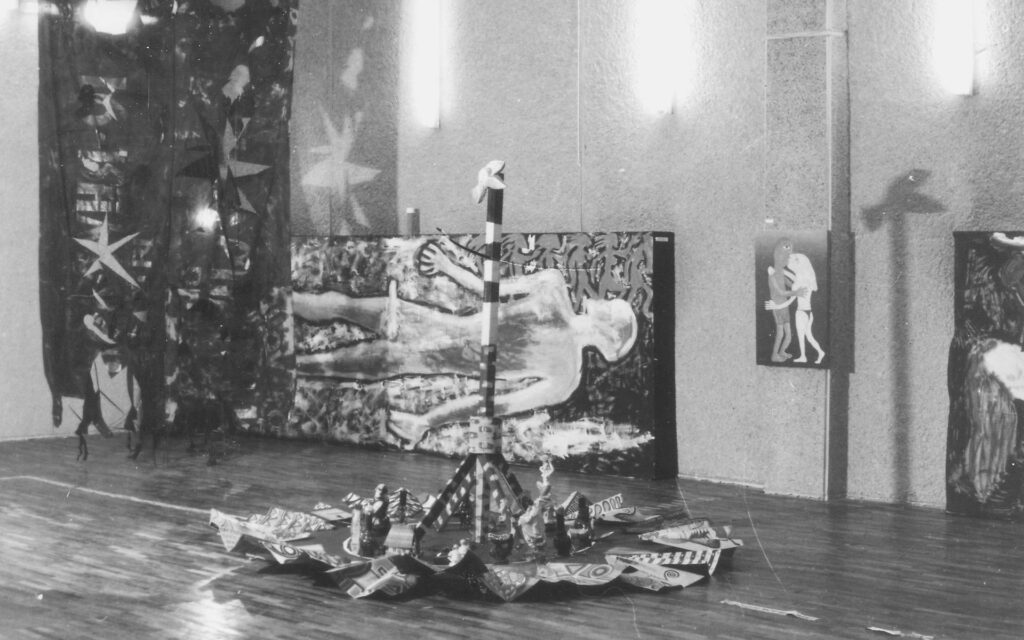
1991


